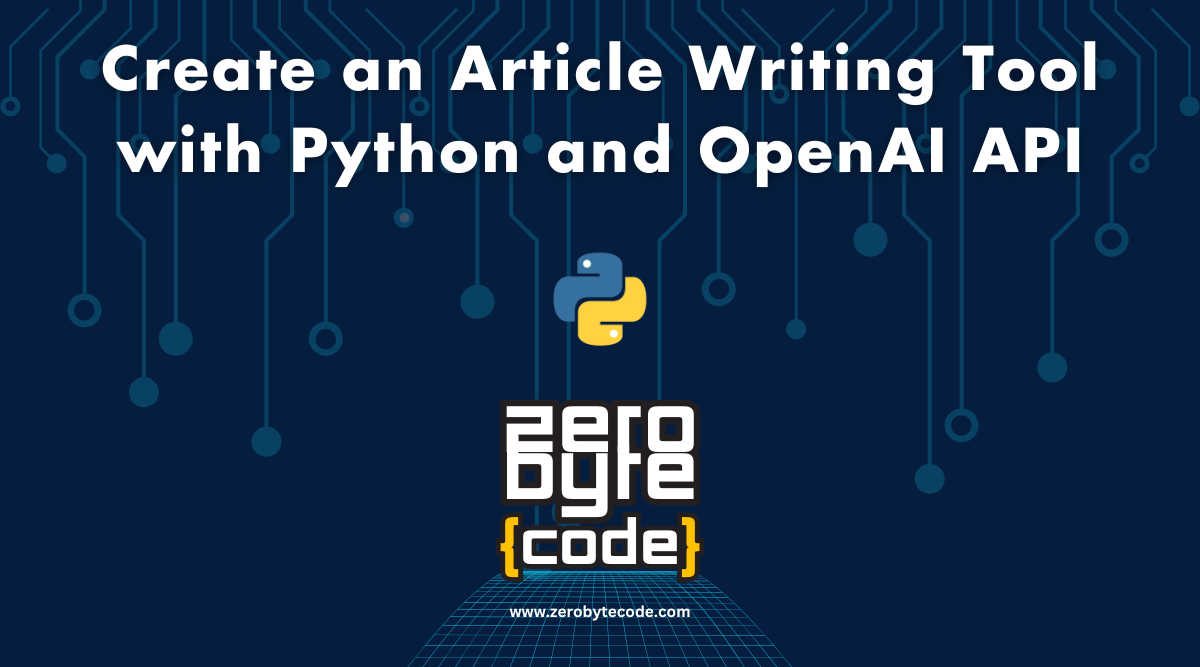How to Create a Simple Article Writing Tool with Python and OpenAI API
How to Create a Simple Article Writing Tool with Python and OpenAI API – In this tutorial, we will create a simple article writing tool using Python and the OpenAI API.
This tool will prompt the user for a topic and generate an article based on that topic using the capabilities of the OpenAI language model.
A Step-by-step Tutorial to Create a Basic Article Writing Tool using Python and OpenAI API
We will cover everything from setting up your environment to writing and running the code. By the end of this tutorial, you will have a working article writing tool which you can adjust and customize later for advance use.
Prerequisites
Before we begin, ensure you have:
- Python installed on your system (Python 3.6+ is recommended).
- An OpenAI API key, which you can obtain by signing up on the OpenAI website.
Step 1: Setting Up Your Environment
First, create a virtual environment and install the necessary libraries.
Creating a Virtual Environment
Open your terminal and run the following commands:
# Create a virtual environment
python -m venv myenv
# Activate the virtual environment
# On Windows
myenv\Scripts\activate
# On macOS/Linux
source myenv/bin/activate
Installing Required Libraries
Install the OpenAI library using pip:
pip install openai
Step 2: Writing the Code
Now, let’s write the code to create our article writing tool.
Importing Required Libraries
Create a Python file, e.g., article_writer.py, and add the following import statement:
import openai
import os
Setting Up OpenAI API Key
Next, set up your OpenAI API key. Replace 'your-api-key' with your actual OpenAI API key.
# Set up the OpenAI API key
openai.api_key = 'your-api-key'
Function to Generate Article
We’ll write a function that takes a topic as input and returns an article using OpenAI’s GPT model.
def zerobytecode_generate_article(topic):
response = openai.Completion.create(
engine="text-davinci-003",
prompt=f"Write an article about {topic}.",
max_tokens=1024,
n=1,
stop=None,
temperature=0.7,
)
return response.choices[0].text.strip()
Main Function to Run the Tool
Finally, we’ll write the main function that will run the tool and interact with the user.
def main():
print("Welcome to the Article Writing Tool!")
topic = input("Enter the topic for your article: ")
print("\nGenerating article...\n")
article = zerobytecode_generate_article(topic)
print(article)
if __name__ == "__main__":
main()
Step 3: Running the Tool
Save your article_writer.py file and run it from the terminal:
python article_writer.py
You’ll be prompted to enter a topic, and the tool will generate an article based on that topic.
Step 4: Enhancements and Customizations
While this is a basic version of an article writing tool, there are several enhancements you can consider to make the tool more robust and user-friendly.
Adding Error Handling
To make the tool more robust, add error handling to manage API errors or invalid inputs.
def zerobytecode_generate_article(topic):
try:
response = openai.Completion.create(
engine="text-davinci-003",
prompt=f"Write an article about {topic}.",
max_tokens=1024,
n=1,
stop=None,
temperature=0.7,
)
return response.choices[0].text.strip()
except openai.error.OpenAIError as e:
return f"An error occurred: {str(e)}"
Customizing the Prompt
Customize the prompt to get more specific types of articles, such as news articles, blog posts, or research papers.
def zerobytecode_generate_article(topic, style="blog post"):
prompt = f"Write a {style} about {topic}."
try:
response = openai.Completion.create(
engine="text-davinci-003",
prompt=prompt,
max_tokens=1024,
n=1,
stop=None,
temperature=0.7,
)
return response.choices[0].text.strip()
except openai.error.OpenAIError as e:
return f"An error occurred: {str(e)}"
In the main function, modify the input to include the style:
def main():
print("Welcome to the Article Writing Tool!")
topic = input("Enter the topic for your article: ")
style = input("Enter the style of the article (e.g., blog post, news article, research paper): ")
print("\nGenerating article...\n")
article = zerobytecode_generate_article(topic, style)
print(article)
if __name__ == "__main__":
main()
Wrapping Up
By following these steps, you can create a basic article writing tool using Python and the OpenAI API.
This tool can be further enhanced with additional features such as saving articles to files, integrating with a web interface, or providing more customization options for the generated content. This setup serves as a solid foundation for more advanced development and customization.







